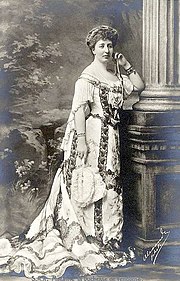Princess Henriette, Duchess of Vendôme and Alençon
| Princess Henriette | |||||
|---|---|---|---|---|---|
| Duchess of Vendôme | |||||
 |
|||||
| Born |
30 November 1870 Brussels, Belgium |
||||
| Died | 28 March 1948 (aged 77) Sierre, Valais, Switzerland |
||||
| Spouse | Prince Emmanuel, Duke of Vendôme | ||||
| Issue |
Marie Louise, Princess Philip of Bourbon-Two Sicilies Princess Sophie Princess Geneviève, Marchioness of Chaponay-Morance Prince Charles Philippe, Duke of Nemours |
||||
|
|||||
| House | Saxe-Coburg and Gotha | ||||
| Father | Prince Philippe, Count of Flanders | ||||
| Mother | Princess Marie of Hohenzollern-Sigmaringen | ||||
| Religion | Roman Catholicism | ||||
| Signature |  |
||||
| Full name | |
|---|---|
|
French: Henriette Marie Charlotte Antoinette Dutch: Henriëtte Marie Charlotte Antonia |
Princess Henriette Marie of Belgium (30 November 1870 – 28 March 1948), Duchess of Vendôme, was the daughter of Prince Philippe, Count of Flanders, and Princess Marie of Hohenzollern-Sigmaringen. She was the younger twin sister of Princess Joséphine Marie of Belgium, who died at the age of six weeks in 1871.
She married in Brussels, Belgium on 12 February 1896 Prince Emmanuel of Orléans, 8th Duke of Vendôme (18 January 1872 Austria-Hungary – 1 February 1931 Cannes, France), He was a son of Prince Ferdinand, Duke of Alençon, and Duchess Sophie Charlotte in Bavaria, and was a great-grandson of King Louis-Philippe of France.
The couple had four children:
Henriette was a great sportswoman, and was often considered the best shot among royal women. On one occasion, she killed a stag that had already killed another, making her very popular in Belgian sporting circles. She even earned the sobriquet the "Sporting Duchess". In 1908, she accompanied her husband to the Rocky Mountains in the United States to shoot grizzly bears.
She often did royal visits for her brother King Albert. In 1914 for instance, she visited a hospital in Neuilly that was treating American troops. In two letters, Henriette and her sister-in-law Queen Elisabeth expressed their appreciation and asked for more support from the American Commission For Relief in Belgium, which had been giving donations to the Belgian people ever since the German invasion.
...
Wikipedia
